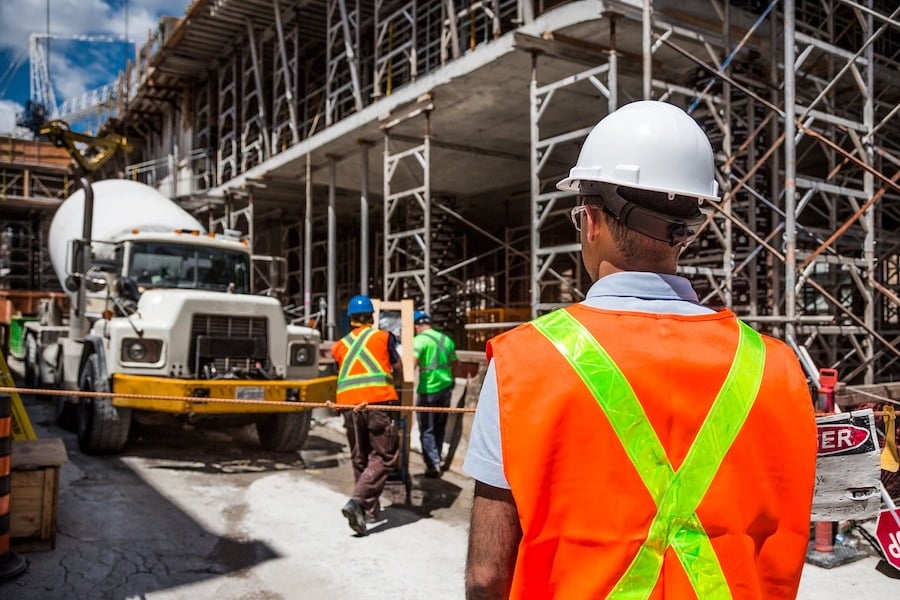6 Important Construction Contract Terms You Shouldn’t Overlook
October 30th, 2019
5 min. read

Those in the construction industry are highly skilled in their respective fields. However, many don’t have a legal background or training on how to decipher the complicated contracts they’re often required to sign with developers and project owners.
Successful contractors build up a clientele and typically enter into contracts with many of the same developers and suppliers again and again. Over time, they get to know the basics but, unfortunately, they can end up signing contracts without really reading them. Typically, there’s no problem... until there’s a problem.
Here, we’ll try to help you make sense of the most common areas that draw confusion so you can know which questions to ask before signing on the dotted line. But before we get to that, let’s clarify one thing...
What Constitutes a Contract?
In its most simplistic terms, a contract is a voluntary written agreement between two or more competent parties that is deliberate and legally binding. Those parties all acquire relative rights and duties that are typically equitable between each other. However, while all parties may expect a fair benefit from the contract, it doesn’t always mean that each party will benefit equally.
Contracts are usually broken into sections with headings to identify what will be covered in each one. Some parts of a contract are self-explanatory, such as who the parties are, the offer and acceptance, or considerations. However, while certainly not an exhaustive glossary of contract terms, the following are common areas that aren’t always cut-and-dried.
1. Services/Scope or Statement of Work
A statement of work (SOW) is intended to provide a clear, complete, logical and concise explanation of the work to be performed. The SOW describes in detail what is expected from the parties and is used as a measuring tool to ensure the project deliverables are met.
The basic concepts to look for in the SOW include:
- Project Overview: a short summary of the project description.
- Project Deliverables: the expected goals and targets that must be achieved through the project, including the project requirements.
- Project Scope: the budget and technical data (if any) including:
- Technical considerations – specific techniques or methodologies relevant to the performance of the project and how it will be measured
- Tasks – specific requests and tasks that are needed to satisfy project objectives, with detailed milestones (where appropriate) and results that should be obtained from these tasks.
- Project Schedule: the project schedule for tasks, important delivery dates, time restrictions and expected project duration.
- Project Management: the primary functions of the project administration, such as payment issuance, process for changes and change control, specific contract terms or other legal requirements, phasing/stages of project, limitations, time management, etc.
2. Insurance
Among the most common construction contract compliance oversights are insurance requirements. Sometimes coverage amounts can be out of balance with the scope of the project, and a contractor can unknowingly take on significant risks. While General Commercial Liability is a standard type of policy that’s required, it doesn’t cover everything. The following are other common insurance matters to look for and review closely:
- Additional Insured provides coverage protection to other individuals or groups that weren’t initially named. For example, a business may ask a contractor to add them as an additional insured in their general liability policy. This is to protect the business in the event of any legal claims that arise as a direct result of the contractor’s work/presence.
- Workers’ Compensation and Disability Insurance is typically indicated in a contract to designate that if one party’s employee gets hurt on the job, the employee will seek compensation from their employer. Typically, you want to pass the risk down as far as possible so that subcontractors take care of their own workers and don’t pursue the contractor if something happens. You may also find a workers’ compensation clause as part of the Relationship of the Parties or Independent Contractor sections of a contract.
- Automobile Coverage/Other coverage should be closely scrutinized. Drivers are legally required to purchase at least the minimum amount of liability coverage set by state law. This statement usually indicates that a party must have their own automobile insurance for any of their employees who work on the premises.
3. Subrogation
Once an insurance company pays out a claim, subrogation enables that insurer to make its own claim against those who may have caused the loss or contributed to it, or another insurance company that insured the parties who caused the damage. After receiving compensation for a claim, the insured party surrenders its rights to its insurance company to pursue a third party in an effort to recoup its losses.
4. Waiver of Subrogation
If subrogation is waived, the insurance company is prevented from sueing the other party to recoup its losses once a claim has been settled. In a nutshell, if subrogation is waived, the insurer is exposed to greater risk. It’s always important to check your policy to make sure that this provision is allowed by your insurance company.
5. Liability / Warranties
A limitation of liability clause attempts to limit the amount of damages that may be recovered for the negligent acts of a party and establishes the maximum exposure of one party if there is a claim. The purpose of these clauses is to project and limit the service provider’s liability in accordance with the level of compensation they receive.
Depending on the terms of the contract, a product warranty may have a statute of repose with a defined warranty period from the completion of a portion of a project. This warranty may extend to a consumer with whom the contractor or manufacturer has no direct contractual relationship.
6. Dispute Resolution
This clause identifies the process by which the parties intend to resolve any disputes that may arise out of their contract. Typically, disputes are resolved in three ways:
- Mediation Agreement — when two parties willingly come together to resolve their dispute under the guidance of a skilled mediator who helps them reach an agreement in a collaborative, consensual and informed manner.
- Arbitration Clause — requires that parties resolve their disputes through an arbitration process. Unlike in court where there may be a jury, parties can select an arbitrator with an appropriate degree of practical experience. Arbitration typically costs less and takes less time than litigation.
- Litigation — if you and someone else enter into a contractual relationship, it is legally binding. One or both of you can force the other to comply with the contract terms by going before a court and asking the court to enforce the contract.
The Importance of a Construction Contract Review
There are many other sections and contract terms to consider aside from those mentioned here, and each can contain nuances and seemingly insignificant wording that can become major issues down the road. This stresses the importance of having someone with legal knowledge review your contract before you sign it to ensure that the conditions laid out are in your best interests.
A simple review can help ensure that:
- The terms and conditions of the contract are satisfactory for you (usually, terms are negotiable between companies).
- There is a complete understanding of everyone involved in the contract.
- All blank spaces are filled in with the appropriate information.
- The terms and quantities are correct.
- Renewal terms are fully understood: Will the contract renew by default? Will the renewed contract be changed from the original?
- Risks have been fairly allocated.
- You’re aware of any indemnification and hold harmless provisions so certain parties will not be held accountable for any damages or losses that come from the contract.
- You understand the terms of default. Under what conditions will a party fail to deliver on the terms of the contract and will they be able to fulfill the conditions without defaulting?
- Any reference documents tied to the contract are known and understood.
- You understand the remedies provisions. What is the worst-case scenario if you default, and can you shift liability to someone else? What actions will you need to take if default happens?
- Significant provisions such as termination, deadlines and important dates, warranties, representations, responsibilities and rights, and dispute resolution are defined and understood.
If your construction business has been signing contracts for years without close scrutiny, you could be putting your entire operation at risk. Fortunately, minimizing risk is at the heart of the team at McClone. Contact us to discuss how a thorough contract review can help ensure you’re properly protected and have the coverage you need to comply with your agreement.
Paul Kaster, JD, MBA, Legal Counsel & Compliance
In his dual role as both legal counsel and compliance officer, Paul provides guidance to our clients on contracts, insurance claims and regulatory compliance. His legal career includes more than 15 years in private law practice and his business career has spanned a variety of industries throughout the Midwest and Southeastern U.S. Paul’s legal experience has included serving as in-house counsel and has covered insurance, construction, litigation, and compliance. He is also a strategic partner to clients on issues related to operations, risk management and business strategy with a demonstrated history of success. He is able to direct high level legal strategic planning and operational initiatives for process improvement through Lean management, M&A, implementation, P&L, budgeting and expansion. At McClone he coaches and empowers both employees and clients to reach their highest potential. Paul holds a bachelor’s degree in political science from the University of Minnesota and an MBA from the Carlson School of Business at U of M. He also has a JD from the Mitchell Hamline School of Law. Paul is very active in the community having served on boards and advisory committees for organizations such as Literacy Green Bay, St. Norbert’s College and Golden House, Inc., a domestic abuse program and shelter.
Topics:












